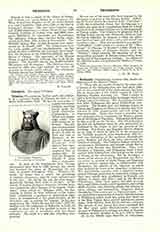

Trissino, GIANGIORGIO, Italian poet and scholar, b. of a patrician family at Vicenza in 1478; d. at Rome, December 8, 1550. He had the advantages of a good humanistic training, studying Greek under the noted Demetrius Chalcondylas at Milan and philosophy under Niccolb Leoniceno at Ferrara. His culture recommended him to the humanist Leo X, who in 1515 sent him to Germany as his nuncio; later on Clement VII showed him especial favor, and employed him as ambassador. In 1532 the Emperor Charles V made him a count palatine. In spite of the banishment from Vicenza pronounced upon him in 1509 because his family had favored the plans of Maximilian, he was held in honor throughout Italy. Wherever he abode his home was a center for gatherings of scholars, litterateurs, and the most cultured men of the time. His family life was far from happy, apparently through little fault of his own. In the history of modern European literature Trissino occupies a prominent place because of his tragedy “Sofonisba” (1515; recent ed., Bologna, 1884), the first tragedy in Italian to show deference to the classic rules. Constantly a partisan of Aristotelean regularity, he disapproved of the genial freedom of the chivalrous epic as written by Ariosto. In his own composition the “Italia liberata dai Goti” (1547-8), dealing with the campaigns of Belisarius in Italy, he sought to show that it was possible to write in the vernacular an epic in accordance with the classic precepts. The result is a cold and colorless composition.
He was one of the many who have engaged in the discussion as to what is true literary Italian. Following the lead of Dante, he espoused in his “Castellano” (1529) the indefensible theory that the language is a courtly one made up of contributions from the refined centers in Italy, instead of being, as it is, fundamentally of Tuscan origin. For clearness he proposed that in writing Italian certain new characters (derived from the Greek alphabet). be adopted to show the difference between open and close e and o and voiced and voiceless s and z. This wise proposition was ignored. “I Simillimi” (1548) which is a version of the “Menaechmi” of Plautus, “I Ritratti” (1524) which is a composite portrait of feminine beauty, and the “Poetica”, which contains his summing up of the Aristotelean principles of literary composition, made up the rest of his important writings. An edition of his collected works was published by Maffei at Verona in 1729.
J. D. M. FORD

